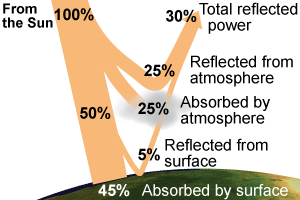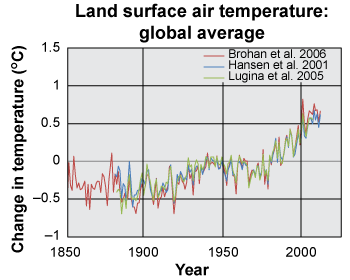|
 The Sun radiates 1,350 W of energy on every square meter of Earth that faces it. About 25% of that radiant energy is reflected from the Earth’s atmosphere, and another 25% is absorbed by the atmosphere. Meanwhile, 45% of the sunlight is absorbed by the Earth’s surface, while 5% is reflected from the surface back into outer space. The Earth maintains its average temperature because it is in thermal equilibrium. But what would happen if the atmosphere suddenly started reflecting more light back into space or if the atmosphere began to absorb more of the Sun’s energy? The temperature on the Earth would change to bring itself back to thermal equilibrium. This is the basic problem posed by climate change.
The Sun radiates 1,350 W of energy on every square meter of Earth that faces it. About 25% of that radiant energy is reflected from the Earth’s atmosphere, and another 25% is absorbed by the atmosphere. Meanwhile, 45% of the sunlight is absorbed by the Earth’s surface, while 5% is reflected from the surface back into outer space. The Earth maintains its average temperature because it is in thermal equilibrium. But what would happen if the atmosphere suddenly started reflecting more light back into space or if the atmosphere began to absorb more of the Sun’s energy? The temperature on the Earth would change to bring itself back to thermal equilibrium. This is the basic problem posed by climate change. 
|
The scientific field of climate change studies broadly involves the following topics: - Global warming deals with direct evidence that the average, global temperature of the Earth has increased over the past century or more.
- Climate change is based on evidence of the effects of global warming, such as rise in sea levels and decrease in sea ice.
- The rise in atmospheric greenhouse gases, particularly carbon dioxide (CO2), provides evidence as to the cause of global warming.
- That human activity has caused much, if not most, of the rise in greenhouse gases is offered as an anthropogenic explanation.

|
 What is the evidence for global warming? Many scientists have been assembling global averages of surface air temperatures taken on land over the past 150 years. The data show a significant rise in average temperature over the past 50 years. Could this be the result of flawed methodology? One indication that it is not is that independent studies, using different methodologies, have reached similar results, known as a consensus.
What is the evidence for global warming? Many scientists have been assembling global averages of surface air temperatures taken on land over the past 150 years. The data show a significant rise in average temperature over the past 50 years. Could this be the result of flawed methodology? One indication that it is not is that independent studies, using different methodologies, have reached similar results, known as a consensus. 
|
 Let’s dig deeper into analyzing the quality of the scientific evidence. Could the land surface air temperature measurements themselves be fundamentally flawed? Other climate scientists have assembled equally detailed sets of data of the marine air temperature, the sea surface temperature, and the temperature of the atmosphere in the lower troposphere. All these separate sets of measurements show similar trends in the change of temperature over the past half century.
Let’s dig deeper into analyzing the quality of the scientific evidence. Could the land surface air temperature measurements themselves be fundamentally flawed? Other climate scientists have assembled equally detailed sets of data of the marine air temperature, the sea surface temperature, and the temperature of the atmosphere in the lower troposphere. All these separate sets of measurements show similar trends in the change of temperature over the past half century. 
|
| |
|

